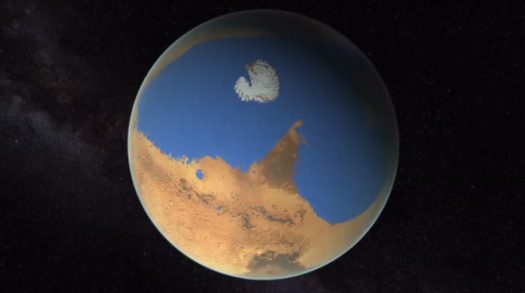
Before the Curiosity rover landed on Mars, NASA’s “follow the water”maxim had already delivered results that suggested a watery past and just maybe some water not far below the surface today that would periodically break through on sun-facing slopes.
While tantalizing — after all, the potential presence of liquid water on a exoplanet’s surface is central to concluding that it is, or once was, habitable — it was far from complete and never confirmed via essential ground-truthing.
Curiosity famously provided that confirmation early on with the discovery of pebbles that had clearly been shaped in the presence of flowing surface water, followed by the months in Yellowknife Bay which proved geologically, geochemically and morphologically the long-ago presence of substantial amounts of early Martian water.
Some of the earliest drilling was into mudstone that looked very much like a dried up basin or marsh, and that was exactly what Curiosity scientists determined it was, at a minimum. It took many months for Curiosity leaders to ever use the word “lake” to describe what had once existed on the site, but now it is a consensus description.
Since the presence of a fossil lake was confirmed and announced, the water story has taken something of a backseat as the rover made its challenging and revelatory way across the lowlands of Gale Crater, through some dune fields and onto the Murray formation — a large geological unit that is connected to the base of Mount Sharp itself. And all along the path of the rover’s traverse mudstone and sandstone were present, a clear indication of ever larger amounts of water.
I spoke recently with geologist and biogeologist John Grotzinger, the former NASA chief scientist for Curiosity and now a member of the science team, to get a sense of how things had progressed for the Gale water story. He said there was no longer any doubt that the crater was once quite filled with water.
“We have not seen a single rock at Gale that doesn’t say that the planet was wet. In the areas where the rover has driven, I’d be very comfortable now in saying that the surface and ground water was often present for millions to tens of millions of years.”

Grotzinger said that the depth of the lakes, basins and playas clearly varied and are not well defined, but the rover’s newest extended mission will shed some light on the issue. That’s because it is now (four years-plus after landing) going to be actually climbing Mount Sharp, it’s original mission goal.
This is of great interest because Mars scientists already know that ahead lies fields of hematite, sulfates and phyllosilicates (clay), all minerals identified from orbit that can only form in water. These deposits higher up the mountain can make the case for a deeper Gale Lake, or they could tell of up-welling ground water. But in either case, they make the case for a watery ancient Mars.
There are innumerable ways in which this Gale water story is important. Since it has been pretty well established that Gale Crater was formed by an asteroid impact 3.8 to 3.7 billion years ago, Grotzinger said that there is some consensus around the view that the water was present at least in the 3.5 to 3.6 billion years ago range.
While those are indeed ancient times — the planet was formed about 4.5 billion years ago — it is quite a bit more recent than what was earlier considered to be the end of the period that early Mars might have supported surface water. In those more conventional models, by 3.5 billion years ago Mars was parched, very cold, and had only the remnants of a protective atmosphere and magnetic field. Yet now it appears that water was common, maybe plentiful.
“Clearly,” Grotzinger said, “there has to be some rethinking about ancient Mars and water. It used to be that watery Mars was thought of as being in the 4 billion years time frame. That has to be revised.”

This presence of substantial amounts of water as late (or later) than 3.5 billion years ago has presented a major problem for Mars climate scientists. By their calculations, there was essentially no way that abundant surface water could be present at that time — especially because of the “faint young sun” paradox.
As first put forward by Carl Sagan and colleagues, the paradox is this: astrophysicists know from the study of stars like our sun that they begin with some 70 percent of the luminosity they will ultimately and gradually reach, and that as a result Mars (and Earth) would have been much colder in early days than it is now. And it’s very cold indeed now.
There has been much discussion in recent years of various ways that a greenhouse effect could have warmed Mars (and Earth) during that early period, but noting conclusive or consensus-building has been identified geochemically on the surface or in the remaining atmosphere of Mars.
What’s more, in order for Gale Lake — and no doubt many others like it – to survive for as long as it apparently did requires a water cycle to replenish the water that is lost. This is where one of the most intriguing and controversial questions about the Mars water story comes in.
It has long been known that much of the northern section of Mars is significantly lower than the southern highlands, and that the lowlands have far fewer geological features. These observations led to the hypothesis some time ago that there was once a large northern ocean on Mars that could replenish the lakes and rivers of the south.

The possible presence of such an ocean has been studied and debated for some time, but Grotzinger said only now is he “getting more sympathetic to the notion.” Many others are also becoming more open to being persuaded because it is extremely difficult to explain the proven existence of large amounts of surface water elsewhere on Mars without such a big liquid source.
Other recent findings and insights are pointing to the existence of a northern ocean as well. For instance, a paper by Michael Mumma and Geronimo Villanueva of the NASA Goddard Astrobiology Center published last year in the journal Science estimated that a Martian ocean once covered 19 percent of the planet. They used ratio measurements of the presence of two variants of water — regular H2O and deuterium or “heavy water” — to conclude that vast amounts of regular water had escaped from Mars over the eons.
And just this summer a team led by Alexis Palmero Rodriguez from the Planetary Science Institute in Tuscon, Arizona found evidence of what they described as ancient tsunami waves on Mars. If confirmed, they could help explain one of the puzzling issues surrounding a potential northern ocean — that features of a shoreline have not been detected so far.
“So, we think this is going to remove a lot of the uncertainty that surrounds the ocean hypothesis,” Rodriguez told BBC News as the tsunami finding. “Features that have in the past been interpreted as relating to an ocean have been controversial; they can be explained by several, alternative processes. But the features we are describing – such as up-slope flows including large boulders – can only be explained in terms of tsunami waves.”
Co-author Alberto Fairen of the Centre for Astrobiology in Madrid said that the team concluded that a big meteorite impact triggered the first tsunami wave about 3.4 billion years ago.
He said the wave was composed of liquid water and formed widespread backwash channels to carry the water back to the ocean.
Their work, which was published in Scientific Reports, centers on two connected regions of Mars, known as Chryse Planitia and Arabia Terra — quite far from Gale Crater.

While the potential existence of an ancient Martian ocean remains the subject of hot debate, the overall Mars water story is now considered pretty firm and with major implications for the potential presence of life on the planet. Early Mars has already been deemed “habitable” by Curiosity scientists in terms of its geochemistry and more, and the presence of lakes or ocean water on the surface for tens of millions of years (or more) could certainly provide conducive places for life to form.
So a next step for Mars science is to determine what kind of Martian minerals best preserve organic material and potential signatures of long-ago life. This field of study is called taphonomy, and Grotzinger was at a taphonomy conference at Williams College when I spoke with him.

“We’re definitely turning the corner from habitability to taphonomy,” Grotzinger said. “This is to prepare for the 2020 mission” to Mars, during which intriguing rocks will be identified for future sample returns to Earth.
The way that exoplanets are studied now and will be in the future is, of course, quite different from what is possible on Mars.
But there are strong parallels in terms of the importance of water and understanding the atmospheric make-up and geochemistry, and there’s this widely-accepted maxim from the world of astrobiology: if a second form of life is ever found on Mars or anywhere else in our solar system, the likelihood that life is common in the cosmos grows exponentially.
Clearly, to have life start twice in our one solar system would make the search for life in other solar systems that much more compelling and pressing.

The ongoing discoveries about mars are simply thrilling. my only wish is that the scientists and researchers would express their views in slightly less arrogant ways – our knowledge is building exponentially, and phrases like “…is the only explanation for…” are cringeworthy. scientific observations show again and again that today’s idea is n o t the only explanation for something.
wouldn’t it be more accurate and appropriate to use terminology that acknowledges the mutability of discoveries and the temporary nature of opinion and theory? let’s teach our children, especially, to welcome change in so many aspects of science and technology as a natural, acceptable thing.
LikeLike